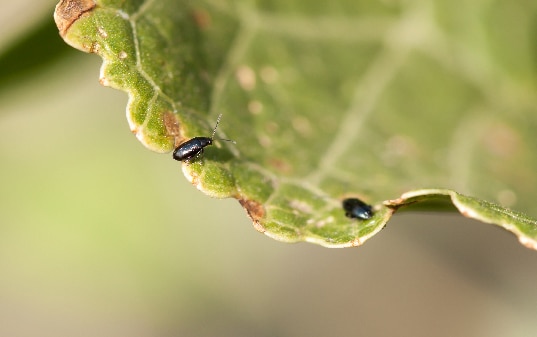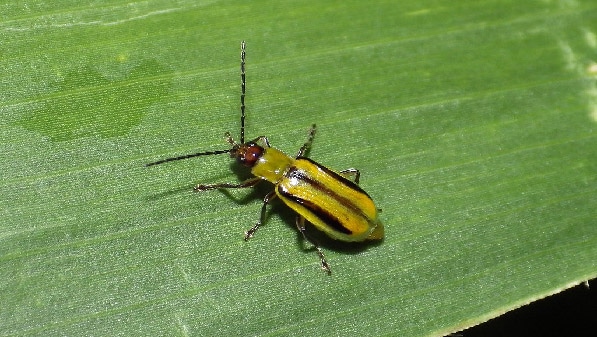
Corn Rootworm
Corn rootworm beetles are yellow with black stripes down the back, sometimes appear greenish in color. CRW feeding on roots causes reduced uptake of nutrients and moisture. Depleted root systems can cause lodging during windy or wet conditions, commonly at pre-tassle, and will “goose-neck” back upright. Any injury to the roots allows other bacteria and fungi to come in and take harbor on the plant for further yield impact down the road (CRW can also feed on the silks of the ear causing a reduction in yield and quality by reducing pollination). Favorable conditions are moist soils near egg laying time and mild winters. Some natural enemies exist but CRW can easily overcome pressures to their populations (crop rotation has the largest impact in reducing CRW populations). Control the larvae by using an insecticide at planting or in the seed treatment and look for traited hybrids that control CRW. If silk feeding is the issue, there is an economic threshold for spraying the cost of insecticide application is usually justified once there are 20 beetles per plant feeding on the silks, or the silks are trimmed to about ½ inch long with 50% of the pollen to be shed.
European Corn Borer
European corn borer mature larvae are around 1 inch in length and are a creamy/grayish color with rows of small marks or circles running down the length of the body. The larvae will feed on all above ground parts of the plant, most commonly found inside the whorl and leaf mid-rid before tassel. In times of later feeding you will find insects in the leaf collar and silks as they begin to tunnel into the ear and stalks. Yields will be reduced as nutrient and water uptake is inhibited, and kernels become damaged. Ear tunneling opens up pathways for other bacteria and fungi to impact the plant, especially molds and mycotoxins which cause after harvest issues. The use of varieties with traits to control ECB- Bt traits, and insecticides partially control ECB. Crop rotation is not an effective management strategy as they can feed on an alternative host crops including soybeans and grasses.
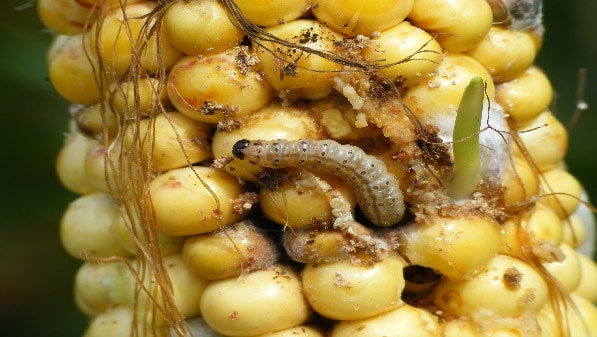
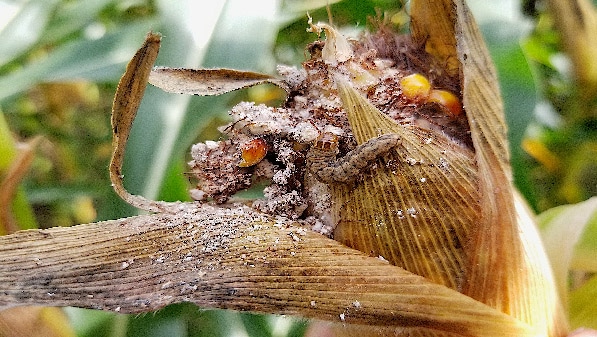
Western Bean Cutworm
Larvae of western bean cutworm are tan/brown color with an orange “cap” on the head with no lines or markings down the back. Adults lay eggs on the upper side of the leaves in the upper canopy. You can see them as you walk through and look up. They are a black/purple color but the larvae eat them once they hatch so you may never see egg masses. Once hatched, they make their way from the leaf to the ear, never feeding on the leaves directly. Direct feeding on the ear reduces quality and yield, and allows for other fungi and bacteria to attack—especially molds and mycotoxins. This may cause issues after harvest in feed out and marketing of the grain. You can find more than one in an ear as they are not cannibalistic. When looking to control WBC, look for varieties that have the Viptera trait as this is the only effective method of control. There are some insecticides labeled for use but are hard when it comes to timing as the larvae must come in contact with the insecticide.
Black Cutworm
Black cutworms can grow to be about 1 5/8 inches in length and are dark brown/black in color. When scouting for them, they can be found in soil or near the surface. Black cutworm chew small holes in the leaves, and cut plants depending on the weather conditions. This mostly occurs above ground in wet soils and below ground in dry soils. Regrowth can occur as long as the damage occurs above the growing point of the plant. Moths are brought up to our region when storms occur before planting and tillage. Tillage should be a common practice in fields with known populations, and some high rates of insecticide will provide moderate control. Broadcast pesticides or baits may be used as a rescue treatment in heavily infested fields, but traited corn will provide the best control against cutworm.
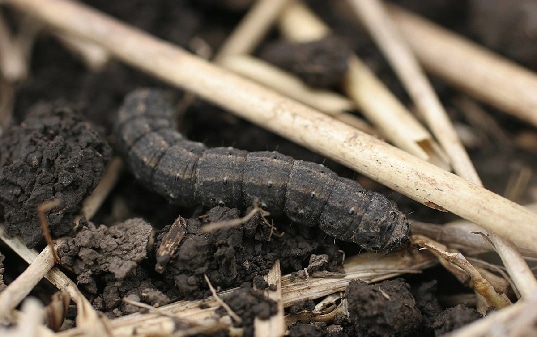
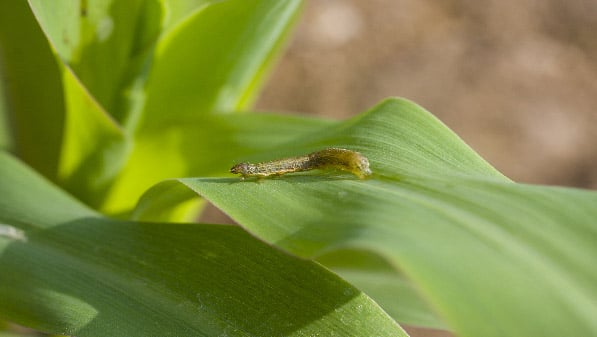
Common Armyworm
Armyworm larvae are about 1½ inches long with two orange stripes along their sides and 2 black stripes down their backs. They have 4 pairs of abdominal legs and their head has 2 vertical bars on the face. They feed only on leaf margins—the mid-rib will remain intact, they do not exhibit tunneling behaviors. Plants will recover from feeding unless the growing point of the plant has been damaged. Black/brown residue may be found around the whorl which is indicative of armyworm feeding. Economic damage is rarely seen. In conventionally tilled fields, reduced till, and heavy grass; the injury may be higher as moths lay eggs in grass prior to corn. For control, select varieties with Bt, manage for the grassy weedy patches near or in the field. Liquid insecticide can also be applied, but only if the larvae are less than 1 ½ inches and there is significant defoliation.
Flea Beetle
Flea beetles are tiny pinhead sized black insects. Most commonly found before the V5 stage in corn. Most damage will occur when plants are growing slowly due to poor growing conditions. Flea beetles strip away the top layer of plant tissue leaving lines or “tracks” on the surface. This will allow bacteria to get into the plant tissue- most commonly Stewart’s bacterial wilt. Stewart’s can then cause leaf wilt and reduce yields. Mild winters will increase flea beetle populations. Flea beetles lay their eggs in weeds and other crops near the host plant. Make sure to manage for weedy patches near the field, especially if the winter was milder than normal.
